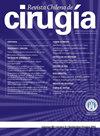这篇文章是我们2011年拉丁美洲和加勒比研究的一部分。根据胃管上升路径进行比较研究
Q4 Medicine
引用次数: 1
摘要
前言:食管切除术后食管吻合口漏是一种与术后发展不良相关的危险事件。其发生频率和严重程度主要取决于手术技术方面。目的:分析食管癌切除术后食管吻合口漏的发生率、处理及预后。材料和方法:对食管癌行食管癌切除术患者的前瞻性肿瘤学数据库进行分析。用费雪精确检验进行统计分析。结果:37例食管癌患者中有34例行全侵入性小食管切除术。79.4%的患者行颈部吻合,20.6%的患者行远端食管切除术加胸内吻合。渗漏率为38.2%(13/34),其中69.2%(9/13)为Clavien - Dindo I - II级并发症。胸骨后胃登突漏率为54.5%(6/11),纵隔漏率为43.7%(7/16),差异无统计学意义(p = 1.0)。再手术率为11.7%,100%继发于纵隔上升,其中3例行胸腔镜下厕所及无名静脉修复。术后死亡率为5.8%,均集中在后纵隔上隆组,但无统计学差异(p = 0.26)。结论:食管癌手术中漏诊较多,尤其是颈食管胃吻合术前路上凸术后。然而,与经后纵隔的胃升肌相比,胸骨后升肌不需要再手术,术后死亡率也不高本文章由计算机程序翻译,如有差异,请以英文原文为准。
Evolución y pronóstico oncológico de fístulas anastomóticas esofágicas en el tratamiento del cáncer de esófago. Estudio comparativo según vía de ascenso de tubo gástrico
Introduction: Post operative leaks of esophageal anastomosis after esophagectomy is a risky event associated with poor postoperative evolution. Its frequency and severity will depend mainly on surgical technical aspects. Objectives: To analyze the frequency, management and prognosis of leakage of esophageal anastomosis after esophagectomy for esophageal cancer. Material and Method: Analysis of our prospective oncologic database of patients with esophageal cancers submmitted to esofagectomy. Statistical analysis with Fisher’s exact test. Results: 34 out of 37 esophageal cancer patients were included submitted to completely invasive mini esophagectomy. Cervical anastomosis was performed in 79.4% of patients, in the remaining 20.6%, a distal esophagectomy with intrathoracic anastomosis was performed. The leak rate was 38.2% (13/34), of these, 69.2% (9/13) correspond to grade Clavien - Dindo I - II complications. The leak rate was 54.5% (6/11) for retro-sternal gastric ascensus and 43.7% (7/16) for mediastinal route, without significative difference (p = 1.0). The reoperation rate was 11.7%, being a 100% secondary to mediastinal ascensus, 3 of them were submitted to thoracoscopic toilets and an innominate vein repair. Postoperative mortality rate was 5.8%, all concentrated in the group of patients with posterior mediastinal ascensus, but without statistical difference (p = 0.26). Conclusion: Leaks are frequent in patients operated on for esophageal cancer, especially after cervical esophago-gastro-anastomosis with anterior route for ascensus. However, retro-sternal ascensus did not require re-operations, nor postoperative mortality compared to gastric ascensus through posterior mediastinum
求助全文
通过发布文献求助,成功后即可免费获取论文全文。
去求助
来源期刊

Revista Chilena De Cirugia
Medicine-Surgery
CiteScore
0.20
自引率
0.00%
发文量
0
审稿时长
6-12 weeks
期刊介绍:
La Revista Chilena de Cirugía es un órgano de difusión del conocimiento y actividad quirúrgica. Su población objetivo son cirujanos, especialistas de otras áreas médicas, médicos generales y alumnos del área de la salud.
Sirve a cirujanos y otros especialistas, para publicar artículos originales e inéditos sobre temas médicos, en particular artículos de investigación básica y clínica, artículos de revisión, entre otros.
Buscan difundir y actualizar el conocimiento médico general y quirúrgico en particular. Se publica en forma bimestral.
La Revista Chilena de Cirugía está afiliada y patrocinada por la Sociedad de Cirujanos de Chilese desde el año 1952.
 求助内容:
求助内容: 应助结果提醒方式:
应助结果提醒方式:


